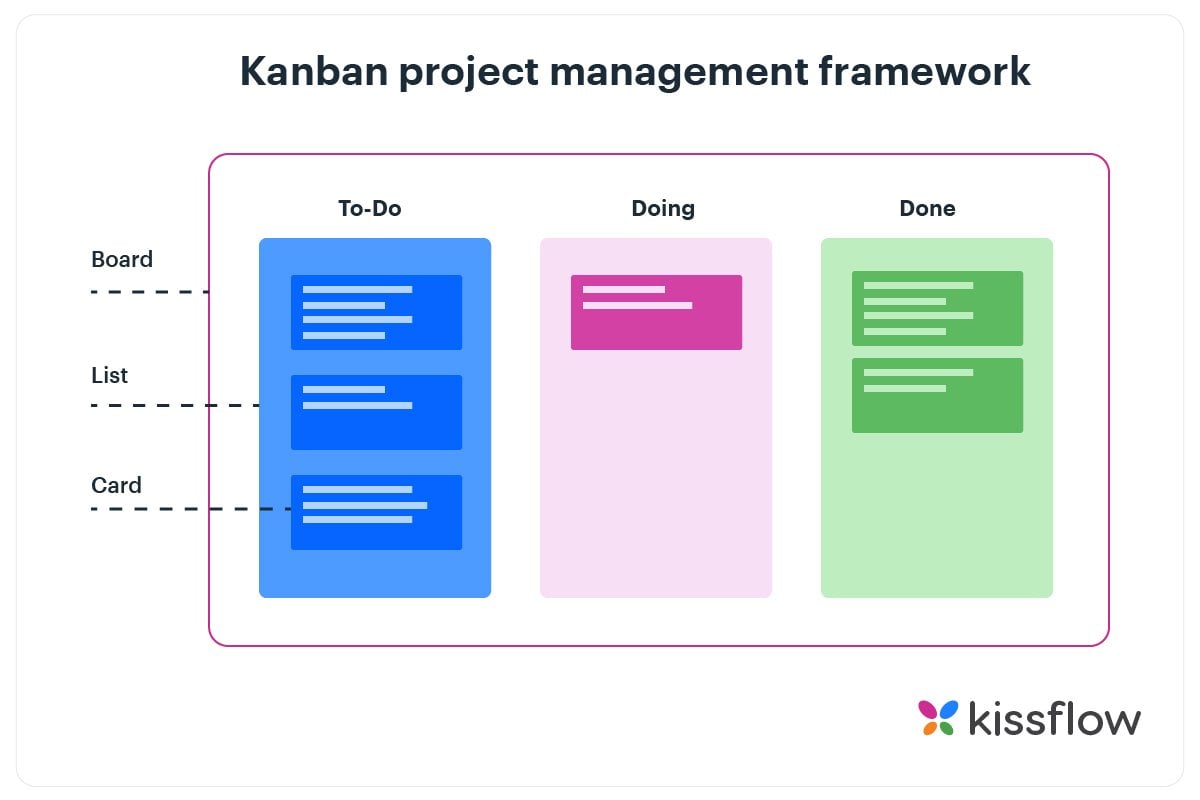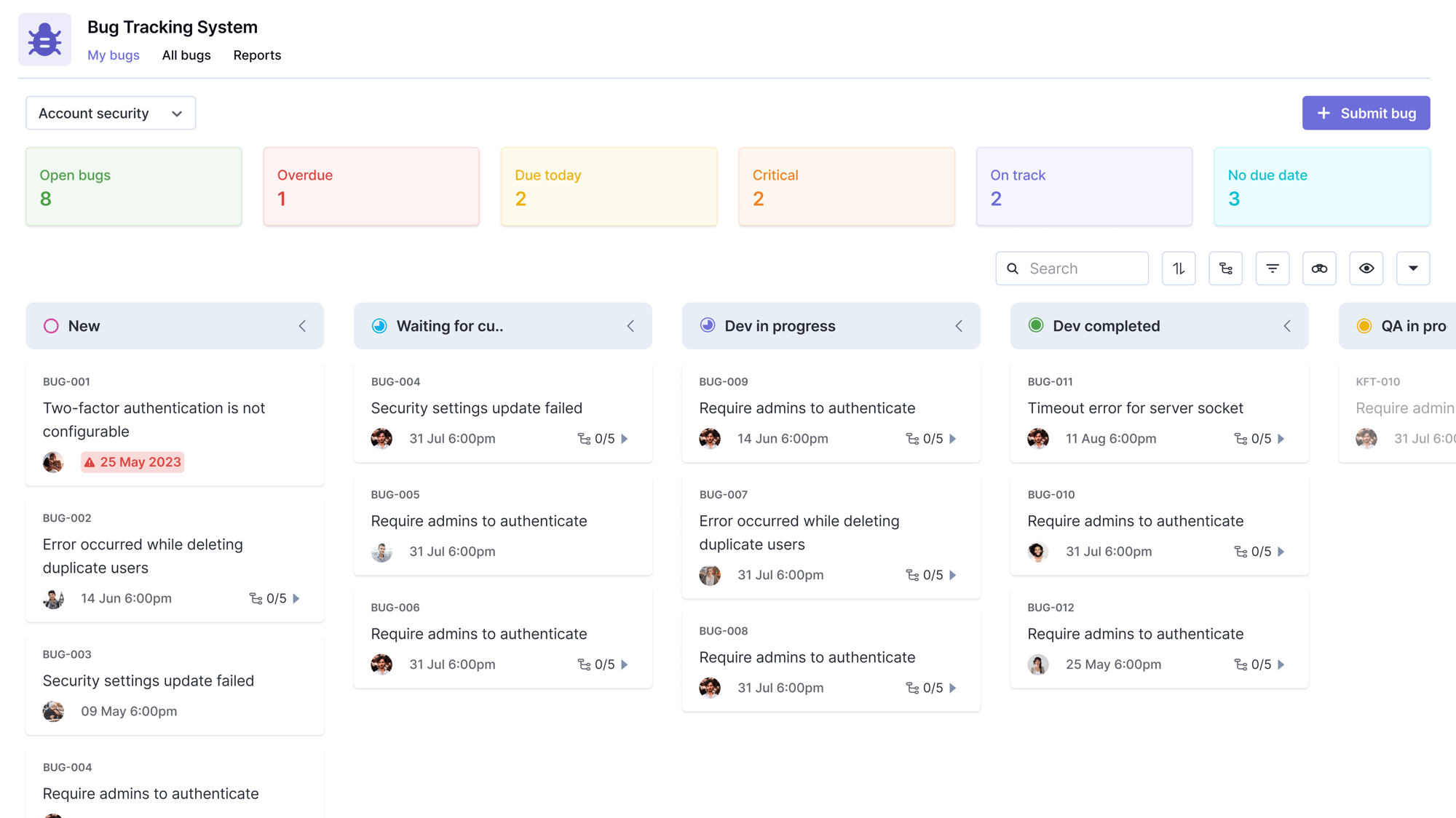Kanban is a framework that falls under the Agile methodology. It was developed in the late 1940s by a Japanese engineer named Taiichi Ohno. Agile Kanban Framework focuses on visualizing the entire project on boards in order to increase project transparency and collaboration between team members.
Kanban is one of the simplest frameworks used as it allows project managers to efficiently manage and keep track of their projects. A distinguishing feature of the Kanban framework among different agile methodologies is its compatibility with the existing organizational setting.
Unlike other popular frameworks, Kanban believes in introducing very small but meaningful changes in the existing setup. This is liked by more traditional organizations where hierarchy and roles of functional managers are considered important.
What is Kanban Methodology?
Kanban methodology is an agile method that aims at continuous improvement, flexibility in task management, and enhanced workflow. With this illustrative approach, the progress of the whole project can be easily understood in a glance.
Kanban was used in manufacturing settings to control inventory throughout the supply chain, using a practice called just-in-time (JIT) manufacturing. In project management, the Kanban methodology adapts the same concept by ensuring that the amount of required work is the same as the work capabilities of the team.
How does Kanban work?
Kanban method revolves around the kanban board. It is a tool that visualizes the entire project to track the flow of their project. Through this graphical approach of Kanban boards, a new member or an external entity can understand what’s happening right now, tasks completed and future tasks.
Kanban board indicates
- the current tasks that are being performed
- the tasks to do in the future
- the tasks that are completed

The divided columns are interconnected and tasks are gradually pulled from the leftmost column (future tasks) to the rightmost column (completed tasks). Kanban system measures the work cycle being completed through the principle of Work in Progress (WIP). WIP has certain limits and a pre-defined specific status.
Limiting WIP in order to maintain consistent standards is one of the core principles that govern the Kanban methodology in Agile. It is extremely important for the team to complete the current tasks in the prescribed order.
Kanban is a pull system
A pull system is a Lean technique that controls the flow of work by replacing what’s completed. A vending machine is a perfect example of a pull system–products will be restocked only when existing products have run out. Kanban precisely fits this definition.
Kanban is about work states unlike Scrum or Agile which focus on sprints and iterations. Kanban focuses on breaking down work into small tasks, visualizing them, and getting few items in any given work state. In the Kanban board, work always moves from left to right. And, you pick work from the column to your left when you have completed all your existing work items or when an urgent task surfaces. The work-in-progress limits help you enforce this.
Tired of using Monday.com?
See why Monday is not efficient to manage projects and why you need a Monday Alternative.
When should you use Kanban?
The versatility of Kanban lies in its simplicity. It fits into your current workflows and respects the existing roles and responsibilities. It can be used irrespective of the industry. A content editor could use it as well as an e-Commerce business.
Kanban can be used in any knowledge work setting and is particularly applicable in situations where work arrives in an unpredictable fashion and/or when you want to deploy work as soon as it is ready, rather than waiting for other work items.
If your priorities change on the fly, and ad hoc tasks can happen anytime, Kanban is best suited as you can add tasks to any work stage. It can also be used when there are no iterations.
Here is our Customizable Marketing Templates to try for Free:
– Marketing Plan Template to Streamline your Marketing Efforts
– Social Media Calendar Template for Social Media Planning
– Discover how Kissflow's low-code platform, Free Demo
Core principles of kanban methodology
Kanban methodology stands on principles and practices. The core principles of Kanban method are as follows:
1. Initiate with the existing workflow:
Kanban framework emphasizes on making small and gradual changes. Therefore, the team must start with the existing workflow and continuously improve the process.
2. Limit the existing tasks:
It is important for the team to realize its own limits and cap the WIP accordingly. Taking on more than you can handle will only waste time and negatively affect the project.
3. Respect existing roles and responsibilities:
An important reason for Kanban’s success is that it does not require organizations to completely overhaul the existing work culture. Many organizations resist modern methodologies because they don’t feel comfortable with change.
With Kanban, efficiency is improved while staying in the confines of the existing setup.
4. Encourage leadership at all levels:
Project management methodologies such as the traditional method require approval from the project manager for even the smallest tasks. Kanban gives the freedom of making decisions to the individual working on the task. This grooms future leaders who continuously learn from their mistakes and improve their work.
Tired of using Asana?
See why Asana is not efficient to manage projects and why you need a Asana Alternative.
Core practices of Kanban methodology
Additionally, using the above-mentioned core principles, the following practices have been established by organizations that use the Kanban methodology.
1. Visualization of workflow:
The whole concept of Kanban revolves around proper visualization of the entire project. Kanban board software is used throughout the industry for this purpose. In the past, people used to get a whiteboard on wheels and use it with the help of different columns and Kanban cards.
This method has now become obsolete as advanced project management tools are now readily available in the market that can make your life much simpler.
2. Reduction of WIP:
WIP in the case of Kanban is supposed to be according to the capability of the team. Usually, a cap is applied to WIP in order to ensure maximum efficiency. On the Kanban board, a limit is applied to the number of tasks that can be performed at once.
No new task can be pulled as long as the limit is achieved, this ensures that the whole team works together and completes all related tasks around the same time.
3. Efficient workflow management:
Measuring lead time and cycle time where lead time, the complete time spent on completing a task is an important parameter that project teams must reduce as much as possible.
4. Explicit management policies:
It is important for the project team to know what they are trying to achieve. The reason behind is quite simple, when someone has a clear project goal in front of them, they’ll try harder to achieve it.
5. Take feedback:
At the end of the day, the most important entity for any business is the client and implementing an effective feedback system is extremely important.
On the Kanban boards, a column can be assigned for feedback from either an external evaluator or the customers themselves. In this way, the quality of the delivered work can be constantly maintained.
And don’t forget to try our Free and Customizable Templates:
– Content Calendar Template for Strategic Content Planning
– Competitive Analysis Template for Strategic Content Planning
Kanban vs Scrum: What’s the Difference?
Scrum and Kanban together are considered the cornerstones of the Agile implementation methodology. According to the ‘Pulse of Profession 2019’ report by PMI, over 57% of organizations used different Agile methodologies and the largest chunk belongs to Scrum and Kanban.
Both Kanban and Scrum focus on consistently delivering the product and keep iterating until perfection is achieved, however, their approach is different. Kanban and Scrum frameworks implement values and principles of Agile manifesto, the way they do that is entirely different.
Scrum revolves around a fixed-length ‘sprint’, and work is completed in small batches. In contrast to that, Kanban focuses on the continuous improvement process and tasks are performed in an orderly manner.
Similarly, changes can be easily made anytime in Kanban as it is task-based while Scrum requires the completion of a single sprint plan before any changes can be made. This makes Kanban a suitable option for projects that are extremely versatile while Scrum is better for projects that require work to be completed in batches.
Kanban also does not have any prescribed roles and no individual is responsible for the team or a task. Scrum, on the other hand, has pre-defined roles of Scrum Master, Product Owner, and Team members.
Benefits of Using Kanban Framework
The main selling point of the Kanban framework is the fact that it significantly improves the way you can handle your projects without changing the organizational structure.
Some of the benefits Kanban methodology offers are:
- Enhanced flexibility
- Continuous improvement
- Increased collaboration
- Employee empowerment
- Smoother workflow
- Better inventory management
- Improved quality control
Implementing Kanban using Kissflow Project
If you find yourself in a position where you are responsible for handling an important project for your organization, don’t worry. Kissflow Project has your back. This intuitive project tracking software is specifically designed for people who have no prior experience with different project management methodologies.
The simply designed interface of Kissflow Project gives you all the freedom in the world to design kanban boards and maintain a workflow that makes Kanban board software incredibly effortless. It comes equipped with customizable project management templates for you to choose from as well. Similarly, Kissflow Project also makes collaboration extremely easy for everyone involved.
Managers can track the progress of the team members in real-time and also send reminders before a deadline. Also, it seamlessly integrates with services like Gmail to ensure team members remain connected at all times and any potential delays can be curbed before it causes any delays in the project.
Although Kanban is an amazing methodology for implementing Agile principles, it comes with its fair share of restriction. Kissflow Project intelligently integrates your organization’s specific requirements with its powerful features and allows you to enjoy all the benefits of kanban board software without worrying about anything. Start using Kissflow Project for free and experience the future of project management on Kissflow Project.
Learn More About Kissflow’s Low-Code Platform and its benefits
Your search for Project Management has landed you here. Wondering why?
As a user, you'll experience the full value of Kissflow by implementing it across departments for diverse use cases rather than just addressing isolated needs like a project management tool for a single team or department.
Application Development Platform
Digital Transformation Platform
Process Owners, Process Heads, and Process Managers must ensure smooth and efficient workflows. Automating processes with a low-code platform enhances agility and accuracy discover how kissflow helps process owners.

%20(2).png?width=2000&name=PSE%20Dashboard%20(3)%20(2).png)
.png?width=2000&name=Dashboard%20(5).png)





